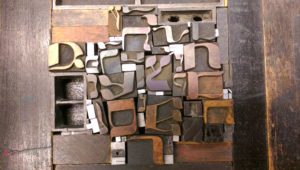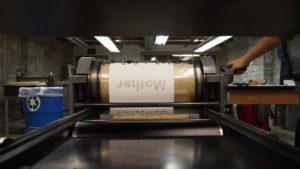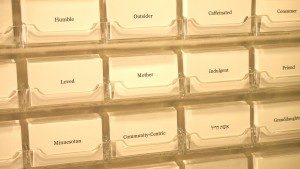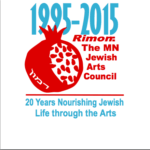Despite her high visibility in the art community, you may not know that Awend is an accomplished artist in her own right. With a BFA from the University of Arizona, and an MFA from the University of Dallas, she specializes in letterpress printing—a technique of relief printing using a printing press—as well as artist books and installation art. Her work has been widely exhibited, and featured on MN Original on TPT- Twin Cities PBS.
I recently caught up with Awend to talk about her unique experience as arts administrator, curator, community liaison, and artist. As we spoke, it was immediately apparent that in all her varied occupations, her passion lies in creating and activating a space for community engagement.
How did you become involved with the Tychman Shapiro Gallery and the Sabes JCC?
As a graduate student at the University of Dallas, I worked in the university’s exhibition space. Moving back to Minneapolis, I connected with the JCC and offered my services as a volunteer in the gallery. When the opportunity to run the gallery presented itself, I moved into the role, and developed it from a quarter-time to a half-time and eventually a full-time position, which I have held for almost ten years. I worked closely with the Tychman Shapiro family to transform the space into what it is now—a viable exhibition space for artists.
How are the exhibits planned?
We aim to engage the community a little differently every time. Our arts and culture department connects the theater, visual arts gallery, and community space, developing seasonal themes, such as humor, holidays, Israel (visiting Israeli artists), literary arts/text, the Holocaust, or political. We then find artists, from local and national to international, whose work fits into those themes, by way of invitation, open calls or curated submissions.
Describe your artistic background:
My work comes from the printmaking field, it is where I got my training, it is what I am passionate about. I work with letterpress printing, using lead and wood blocks of letters. My imagery revolves around language: letters of the Hebrew and English alphabet, and the biological language of chromosomal pieces, cells, and DNA.
It is a process that requires a high degree of craftsmanship and time.
I love the process of printmaking, I love the magic of it!
Your most recent work is interactive, artwork that invites the community/audience to take an active role in the creative process. How did you make that transition?
Because my life has changed so much, I have less time to work in the process-heavy way required for printmaking. My practice has migrated toward interactive installation work, which requires thinking time but does not demand a lot of execution time in the studio. For example, I created a self-portrait composed of 48 words surrounding identity. I made a list of words that represented where I was in my life at that moment.
Some words were conditions that were constant: daughter, mother, artist. Some words depicted things that could change over time: caffeinated, indulgent, outsider. Each word was printed on a stack of 100 business cards, and displayed in one large business card holder with 48 different slots. People were invited to take whatever cards they connected with, for themselves or for someone else. It was a way to create a connection between the artist and the viewer. People took cards and put them in their wallet, next to their ID. One viewer rearranged the order of every stack of cards to create a narrative.
Traditionally, the process ends when the artwork leaves your studio. Here it begins—or at least it is half-baked—when it leaves your hands, and becomes a work of art through the interaction with the audience.
Yes, it is a fun and creative interaction. Another piece was a word search puzzle. It contained over 100 words that related to “light”, but did not include the key. The puzzle was printed on a huge blueprint printout, and displayed with red markers. The audience was invited to find words without knowing what to look for. Some found words I had not intended, words in other languages, or added letters to make new words, going out of the grid.
There is so much hope and optimism in allowing the audience to build something together, the audience in effect becoming the artist.
You have to trust. Give up control. The artwork could go in any way, intended or unintended, it could even be destroyed. I like that exchange, and knowing that the best that can happen outweighs the worst that can happen.
For more on Robyn Awend, please visit http://www.robynstollerawend.com/






